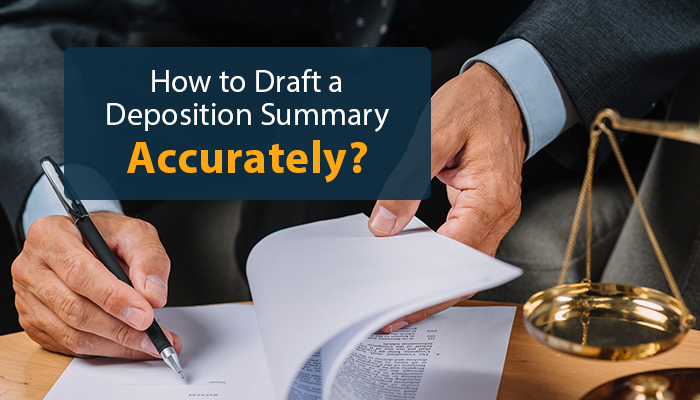
1000+
customers

50+ countries
across the world

Outsourcing leader
since 2008

Technology-driven
services

Stringent
quality processes
The Complete Guide to Drafting a Deposition Summary Proficiently!
Last updated: 15 Mar, 2024 By Ritu Kaushal | 6 Minutes Read

Depositions hold immense importance in civil litigation and are one of the essential tools used in the discovery process, making it a must for every lawyer to learn how to do deposition summaries efficiently. It takes into account the precise testimony of the witnesses that can be brought into use during trial time. It is quite challenging to summarize the deposition testimonies in an accurate, concise, and crisp manner. Most busy law firms seek the help of legal support services for word-by-word transcripts of court depositions, meetings, briefs, interrogations, legal examinations, hearings, and more. However, the documentation process doesn’t get completed here. This is due to the fact that deposition contains more information than required and needs to be summarized so that a concise overview is available for use during the trial.
What is a Deposition Summary?
Summarizing a deposition is nothing but a condensed, objective, and accurate clerical synopsis of the main points that are included in the deposition transcript. This synopsis is in compliance with the original deposition’s lines and pages, making it extremely easy to pinpoint the essential details and verify them with the verbatim transcript as required.
The summary of deposition is very important in the complete litigation process, including discovery, trial, and motion practice. These summaries support attorneys in the following:
- Getting prepared for pretrial motions and ensuing depositions
- Getting prepared for a trial witness exam
- Preparing successive discovery demands and responses, as well as interrogatories
- Identifying noteworthy testimony and concerns for trial witness impeachment
Defining the Deposition Summary Objective
As stated above, the objective of a deposition summary is to present a summarized version of the deponent’s testimony in an accurate and concise manner to the reviewing party. The deposition summary should cover the main and relevant points of the deposition only, focusing on the following:
- Describing a deposition for the insurance client or adjuster
- Refreshing recollection of the witness before the hearing or trial
- Preparing other depositions of the same case
- Preparing additional discovery
- Assisting attorneys not present at deposition
- Enabling attorneys to prepare motions and evidence better
- Supporting trial preparation
- Summarizing jurors’ testimony at the trial
The Deposition Summary Process
The deposition summary process comprises 3 basic steps:
- Reading: This includes going through the entire transcript and focusing on questions asked by attorneys and witness’s responses.
- Annotating: This includes highlighting the key points that need to be included in the summary.
- Summarizing: This includes organizing the key points in the format of a chart, including columns like “Testimony,” “Topic,” and “Page/Line.” Summaries can be prepared in an outline or narrative format.
Key Deposition Summary Essentials
1. Do Background Work
Before summarizing depositions, make sure you go through the pleadings. This will help in drafting with more focus and clarity. Carefully read and know exactly whether the complaint is of the plaintiff or his witness. On the contrary, read through the deposition answer to know if it is of the defendant or his witness. Focus on allegations and supporting facts while reading the pleadings.
2. Prioritize Information
It is vital to prioritize the information in the deposition summary. First of all, make sure no unrelated information exists in the summary. Secondly, summarize the key points only so that it helps readers understand things in a timely and accurate manner. As a general rule, one should summarize 5 pages of testimony into 1 single page. This will speed up the trial process and verdict.
3. Include Essential Details
You must leave out the information that is of little or no value in the deposition summary but include every essential detail that may be helpful for the lawyer. This even includes the breaks taken by the witness to let the readers know that a break was taken between specific statements and help them easily locate the relevant summary parts.
4. Work on Presentation
Lastly, make sure that you are presenting your deposition summary in an eye-catching way since the presentation creates a lot of impact on the minds of the readers. For instance, try to provide the summary in a format that has two columns: a wide column on the right and a narrow column on the left.
Apart from this, keep the line and page numbers in the left column and the testimony summary in the right column, including the date, case, and witness name. If needed, a table of index or contents can be included too.
Benefits of a Well-Documented Deposition Summary
1. Deposition Summary helps in Time-Saving –
Time is crucial in legal cases, and a deposition summary helps save time at large by providing a quick reference to main testimony points, enabling lawyers to focus on trial preparation and case strategies instead.
2. Convenience –
A deposition summary provides great convenience to the lawyers since he doesn’t have to go through the entire testimony but simply review the key facts.
3. Pretrial Preparation Help –
This helps a lot in pretrial preparation as a lot of effort and time are saved with respect to reviewing the entire testimony, and the same can be used to prepare for the trial.
4. Deposition Summary Helpful in Technical Testimony Cases –
Witnesses who are technically qualified provide technical testimonies against personal injury, workers’ compensation, etc., that are essential to the trial process. Also, it aids in locating discrepancies through cross-verification amongst various deponents.
5. Useful for Everyone –
The deposition summary is helpful for everyone, including assigning attorneys, insurance companies, other clients, litigation team members, etc.
Conclusion
A deposition summary is of great help to not only the lawyers but others involved in the trial as well. However, deposition summary services should be employed to ensure it is well-documented and presented in an organized way to save the time and effort of lawyers and people going through it. Lawyers can utilize this time in trial preparation and executing other important tasks.
However the problem occurs when lawyers have to manage the non-core tasks of a plethora of cases simultaneously. This is where litigation support services come to their rescue.
In case you are a busy lawyer or an owner of a legal firm and are feeling overwhelmed with work, you may consider joining hands with Cogneesol. It has been providing qualitative legal support solutions to attorneys and legal firms worldwide since 2008. Contact us to start your free trial!
Also Read :
3 Ideal Ways to Keep a Check on Your Litigation Costs
Why is there an Increase in Litigation Support Outsourcing?
Why Law Firms Should Consider Legal Administration Outsourcing?
Latest Blogs

This site is protected by reCAPTCHA. Google's Privacy Policy
and Terms of Service apply.










